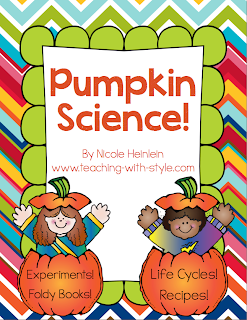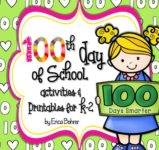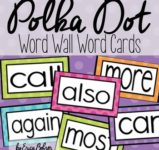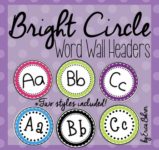To prepare the students for my observation, I wanted to immerse the students in all things pumpkin. We touched pumpkins on the inside and outside (Cara Carroll & Deanna Jump’s ideas). We created many anchor charts.
Then we focused on informational text features. I had the students label informational text features. I did this by scanning pages from a couple of bat themed books. I then printed and laminated the scans and taped them to chart paper. Throughout the year, I have been trying to stop and point out text features during read alouds and guided reading. I created text feature definition cards. I mounted them on cardstock and laminated them. Then for a lesson, I read the text feature cards (click here to snag yours for free) and had the students match the cards to the feature. The completed anchor chart is now on display in the classroom for the students to use as a reference.
The students then worked in pairs to use post its to label the informational text features. They struggled with “heading” and would often write the actual heading of the book. This helped me plan my observation lesson.
For my observation lesson, we reviewed the informational text features and completed the anchor chart matching activity for a second time. Then we applied our pumpkin learning to what we knew about informational texts and created possible headings for our own informational writing pieces on pumpkins.
The students turn-paired-shared the headings they wanted to write about. Once at their seats, they filled in their heading on their writing paper. I walked around and reminded the students to stay focused on the topic of the heading. I also encouraged the students to add other informational text features to their writing. I was really impressed with the writing and the application of informational text features. I am trying to follow Teachers College philosophies and not stifle the kids with spelling and recopying…just let them write. We can work on grammar and spelling in centers and during mini-lessons. I am planning mini-lessons and pulling small groups based on the writing issues I notice. For example, I have many students who need to work on rereading their writing and asking if the sentence makes sense. I have few students with spacing issues and some that seem ready to work on adding more details or descriptive language. Check out some of my top writer’s informational pieces from this lesson.
We are still working on our pumpkin informational pieces and I hope that they get to finish them this week, so that we can dive into bats!
Thanks for stopping by! Also, thank you to all of you who are new fans and old. I appreciate your support. Five years on TpT flew by!











































Thanks for the great visuals and the informational text freebie! Hope your Halloween Week is great.
Iteachkidsabc@gmail.com
:o) V.
Special Teacher for Special Kids
You highlighted so many awesome resources, Erica! Thanks for the freebie text features lesson, too! 🙂
Nicole
Teaching With Style
I'm getting observed tomorrow too and also doing non-fiction text features with a bat twist! I love this pumpkin stuff! I may snag it up for next week!
Jess
The Teacher Talk
I love your pumpkin unit!!! Thanks so much for the freebie! I hear you about reinventing the wheel…21 years in the classroom and I never do the same thing each year! I'm always creating something new. Have a great week ahead!
Hi Erica,
I love all of your units. Thanks so much. However this year I am teaching 3rd and 4th grade. Do you know of any fantastic blogs or excellent 3rd/4th grade teachers that create fantastic units like yours? Thanks in advance 🙂
Thanks for the great ideas! The informational text freebie will come in handy! Thanks for sharing.